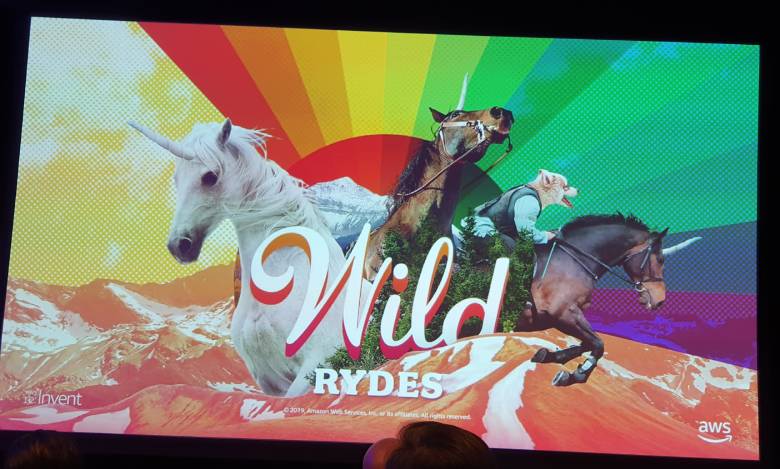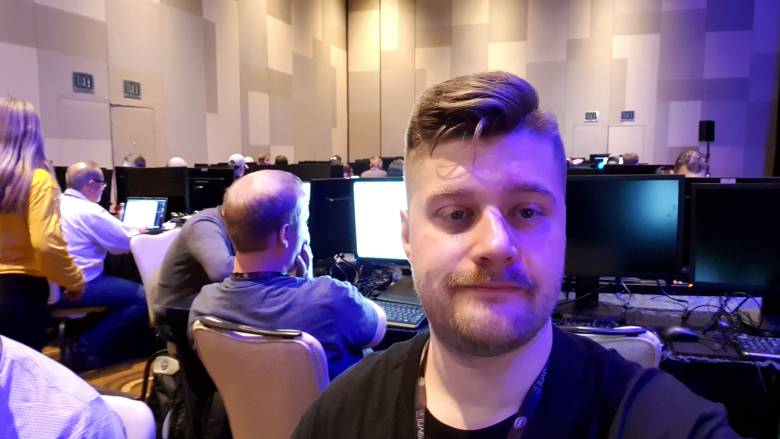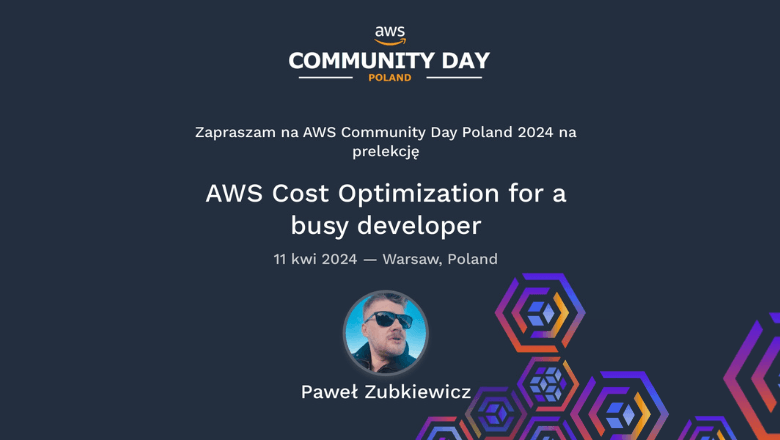
Poniżej lista prezentacji na których byłem osobiście i polecam. Sesje maja na końcu nazwy numery, odpowiednio 100 to poziom początkujący, 200 i 300 to średnio i zaawansowany, a 400 to poziom ekspert.
AWS re:Invent 2019: [REPEAT 1] Serverless at scale: Design patterns and optimizations (SVS335-R1)
Z prezentacji dowiesz się m.in. jak działa współbieżność w usłudze AWS Lambda, jak zachowuje się throttling oraz jak można zwiększyć ilość równoległych wywołań funkcji Lambda aż do 4000 z domyślnego limitu 1000. Mega wartościowa wiedza.
You’ve built your first serverless application, and it works beautifully. As traffic increases, you might discover that small changes make a big difference in performance or cost. In this session, we explore the common challenges that customers encounter at scale with early serverless architectures and the approaches to optimize them.
ARC411-R1 – [REPEAT 1] Reducing blast radius with cell-based architectures
Świetna prezentacja z której dowiedziałem się jak AWS projektuje swoje własne usługi. Używają właśnie cell-based architecure. Niestety nie ma jej na YouTube 😡 Jeśli jest już dostępna gdy czytasz ten tekst to daj mi proszę znać a zaktualizuję stronę.
One thing we’ve learned is that failures come in many forms, some expected and some unexpected. A core consideration is how to minimize the blast radius of any failures. In this talk, we focus on cell-based architectures; system, cell, and router properties; and how we designed for failure on AWS leveraging serverless technologies like AWS Lambda, Amazon Kinesis, Amazon Simple Storage Service (Amazon S3), and Amazon Simple Queue Service (Amazon SQS). This cell-based architecture processes 28 petabytes of data with 1 billion transactions a month.
AWS re:Invent 2019: [REPEAT] Serverless SaaS deep dive: Building serverless SaaS on AWS (ARC410-R)
Ta sesja wysadziła moją głowę w powietrze 🤯🤯🤯 Jeśli chcesz zbudować serverlessowy multi-tenant SaaS to KONIECZNIE MUSISZ obejrzeć tą prezentację. Uwaga poziom 400 jak najbardziej zasłużony!
The emergence of serverless infrastructure and services represents a fundamental shift in how developers approach architecting applications. This is especially relevant in the world of SaaS, where systems must efficiently and cost-effectively respond to continually shifting multi-tenant loads and profiles. In this session, we dive into all the moving parts of a serverless SaaS application, exploring the detailed code, design, and architecture strategies that are commonly applied to support the complex scale and agility requirements of multi-tenant serverless SaaS environments. We also look at how serverless influences core multi-tenant strategies, including tenant isolation, service decomposition, management, deployment, and identity.
AWS re:Invent 2019: [REPEAT 3] Serverless architectural patterns and best practices (ARC307-R3)
Kolejna prezentacja oferująca przegląd najlepszych praktyk i wzorców ze świata serverless.
As serverless architectures become more popular, customers need a framework of patterns to help them to identify how to leverage AWS to deploy their workloads without managing servers or operating systems. In this session, we describe reusable serverless patterns while considering costs. For each pattern, we provide operational, security, and reliability best practices and discuss potential challenges. We also demonstrate the implementation of some of the patterns in a reference solution. This session can help you recognize services and applications for serverless architectures in your own organization and understand areas of potential savings and increased agility and reliability.
AWS re:Invent 2019: [REPEAT 1] Moving to event-driven architectures (SVS308-R1)
EDA to architektura, która w chmurze czuje się jak ryba w wodzie. Zaryzykuję stwierdzenie, że bez jej znajomości nie sposób projektować rozwiązań Cloud Native. Na dokładkę wiele ciekawych informacji na temat usług AWS.
Event-driven architectures are getting a lot of attention. We have recently invested in tools and infrastructure to make event-driven architectures easier to implement and operate. In this session, we discuss what events are, why the community is increasingly interested in event-centric applications, and what’s new in the domain and with AWS in particular. In addition, we discuss the challenges that still face us and our customers. By the end of this session, you understand the key principles and benefits of being event-driven.
AWS re:Invent 2019: [REPEAT 1] Optimizing your serverless applications (SVS401-R1)
Jeśli chodzi o wzorce i dobre praktyki to ta prezentacją jest obowiązkowym punktem. Szczerze mówiąc poziom 400 to trochę na wyrost moim zdaniem i nie usłyszysz tutaj nić co zwinie Twój mózg w pół. Na dodatek, prezentacja uwzględnia wiele nowości, które pojawiły się w ostatnich miesiącach 2019 jak i na samym re:Invent.
Are you an experienced serverless developer? Do you want a handy guide for unleashing the full power of serverless architectures for your production workloads? Are you wondering whether to choose a stream or an API as your event source, or whether to have one function or many? In this session, we discuss architectural best practices, optimizations, and handy cheat codes that you can use to build secure, high-scale, high-performance serverless applications. We use real customer scenarios to illustrate the benefits.
Inne sesje godne uwagi
AWS re:Invent 2019: [REPEAT 1] Amazon DynamoDB deep dive: Advanced design patterns (DAT403-R1)
Rick co roku wygłasza tę samę prezentacje, oczywiście aktualizuje ją i co roku jest ona fenomenalnie odbierana przez widownię. Myślę, ze ma juz kultowy status w światku użytkowników serverless. Niektórzy twierdzą, że jest legendarna. Dotyczy ona bardzo zaawansowanych sposobów projektowania tabel DynamoDB, więc uważaj bo może się okazać, że w trakcie oglądania Twój mózg się przegrzeje 🔥 (nie żartuję, ja gdy pierwszy raz oglądałem to przestałem ogarniać o czym Rick mówi gdzieś w połowie 🤯).
This technical session is for advanced users of Amazon DynamoDB. The patterns and data models discussed in this presentation summarize a collection of implementations and best practices used by large customers—including Amazon retail businesses—to deliver highly scalable solutions for a wide variety of business problems. We delve into strategies for global secondary index sharding and index overloading, scalable graph processing with materialized queries, relational modeling with composite keys, executing transactional workflows on DynamoDB, and more.
AWS re:Invent 2019: [NEW LAUNCH!] Building event-driven architectures w/ Amazon EventBridge (API320)
EventBridge to świetna usługa dlatego warto ją poznać i używać.
Companies are increasingly opting to build applications using event-driven architectures to improve application scalability and reliability. In this session we’ll review the basics of event-driven architectures, and reveal how new features in Amazon EventBridge can dramatically reduce the time and code required to build applications that react to events. EventBridge can now discover the available events and automatically generate code from their structure and contents. Through use cases and examples, we’ll review how to simplify the process of ingesting, routing, and processing events from your own apps, AWS services, or SaaS apps. With the launch of schema registry, Amazon EventBridge can now discover the available events and automatically generate code from their structure and contents.
AWS re:Invent 2019: [REPEAT 1] Building microservices with AWS Lambda (SVS343-R1)
Dobre overview na temat budowy mikroserwisów na AWS przy pomocy Lambdy. Trochę praktycznych informacji i wiele wysokopoziomowych rad dotyczących użycia wielu usług.
Many developers have become familiar with building microservices on traditional compute offerings such as virtual machines and containers, but what about serverless? The “functions as a service” model behind AWS Lambda presents a number of unique differences while still providing many benefits that make it a strong fit for microservices-based architectures. In this session, we talk about mapping microservices-based architectures to Lambda’s event model. You learn how to think about the bounds of functions and their alignment to the services represented. We then cover patterns that enable rapid development and easier testing. Walk away ready to build your next microservice with AWS Lambda.
AWS re:Invent 2019: A day in the life of a Netflix engineer (NFX202)
Widziałem starszą wersję tej prezentacji, gdziś kiedyś. Myślę, że każdego inżyniera oprogramowania zaciekawi 🤔
Netflix is a large, ever-changing ecosystem serving millions of customers across the globe through cloud-based systems and a globally distributed CDN. This entertaining romp through the tech stack serves as an introduction to how we think about and design systems, the Netflix approach to operational challenges, and how other organizations can apply our thought processes and technologies. In this session, we discuss the technologies used to run a global streaming company, growing at scale, billions of metrics, benefits of chaos in production, and how culture affects your velocity and uptime.
Warsztaty
Było ich sporo na re:Invent ale tez nie było łatwo się na nie dostać, gdyż ilość chętnych była ogromna. Ja uczestniczyłem tylko w dwóch.
SVS203-R - [REPEAT] Build a serverless ride-sharing web application
Bardzo przyjemne warsztaty na których można się nauczyć Amplify. Amazon Amplify to framework, który służy do budowy serverlessowych backendów od strony frontendu.
In this workshop, you deploy a simple web application that lets users request unicorn rides from the Wild Rydes fleet. The application presents users with an HTML-based user interface for indicating the location where they would like to be picked up and interfaces on the backend with a RESTful web service to submit the request and dispatch a nearby unicorn. The application also provides facilities for users to register with the service and log in before requesting rides

https://github.com/aws-samples/aws-serverless-workshops
SVS303-R - [REPEAT] Monolith to serverless SaaS: A hands-on service decomposition
Bardzo ciekawy warsztat w swoim zamierzeniu, podzielony na 4 etapy w których krok po kroku migrujemy tradycyjna (legacy) aplikację napisaną w Java EE do serverlesss. Niestety nie udało mi się go skończyć w trzy godziny.
The move to a serverless model is especially appealing to SaaS providers. For many, this journey begins with transforming their legacy, single-tenant monolithic architecture into a multi-tenant serverless solution. In this workshop, we dive into the heart of this challenge, walking through the incremental steps required to map your monolithic application to a series of AWS Lambda-based microservices. We then use Lambda layers to add tenant-aware logging, metrics, and data access to your Lambda functions. Throughout, we expose the fundamental moving parts of this transformation, highlighting common considerations that can affect your serverless SaaS migration strategy.

A tak wyglądały warsztaty.
(Opisy sesji są własnością AWS lub ich autorów)









